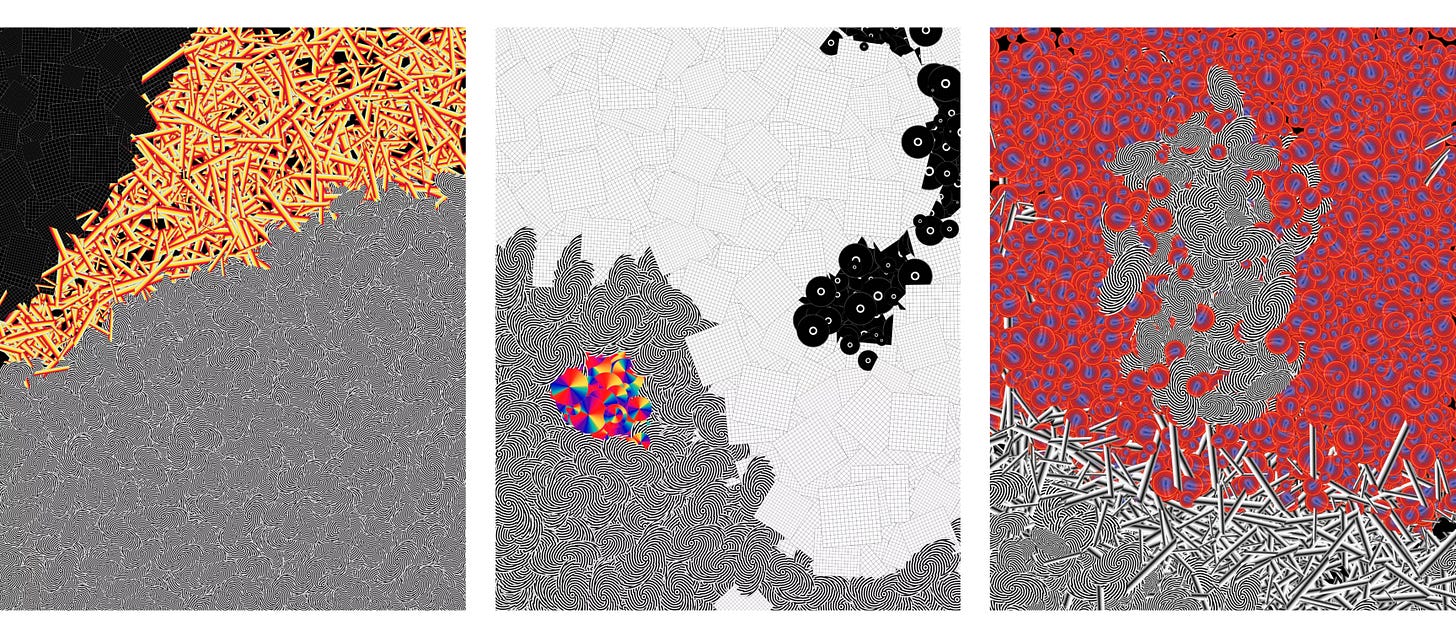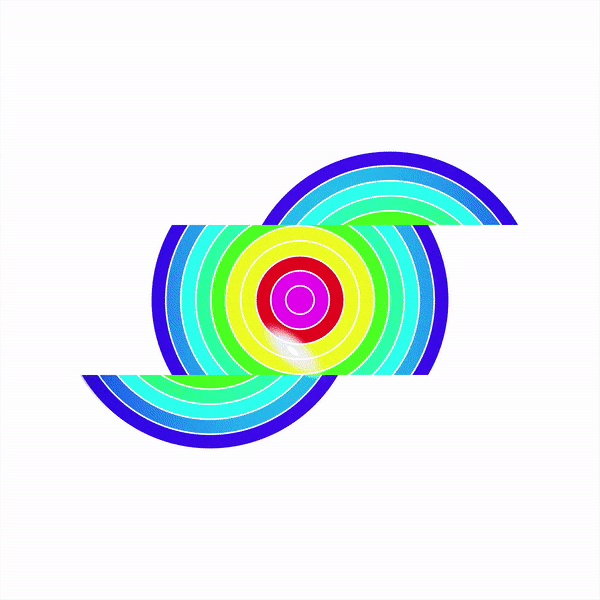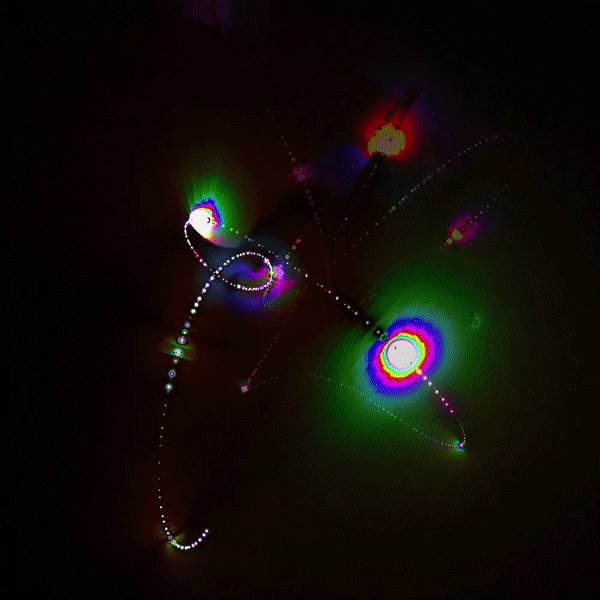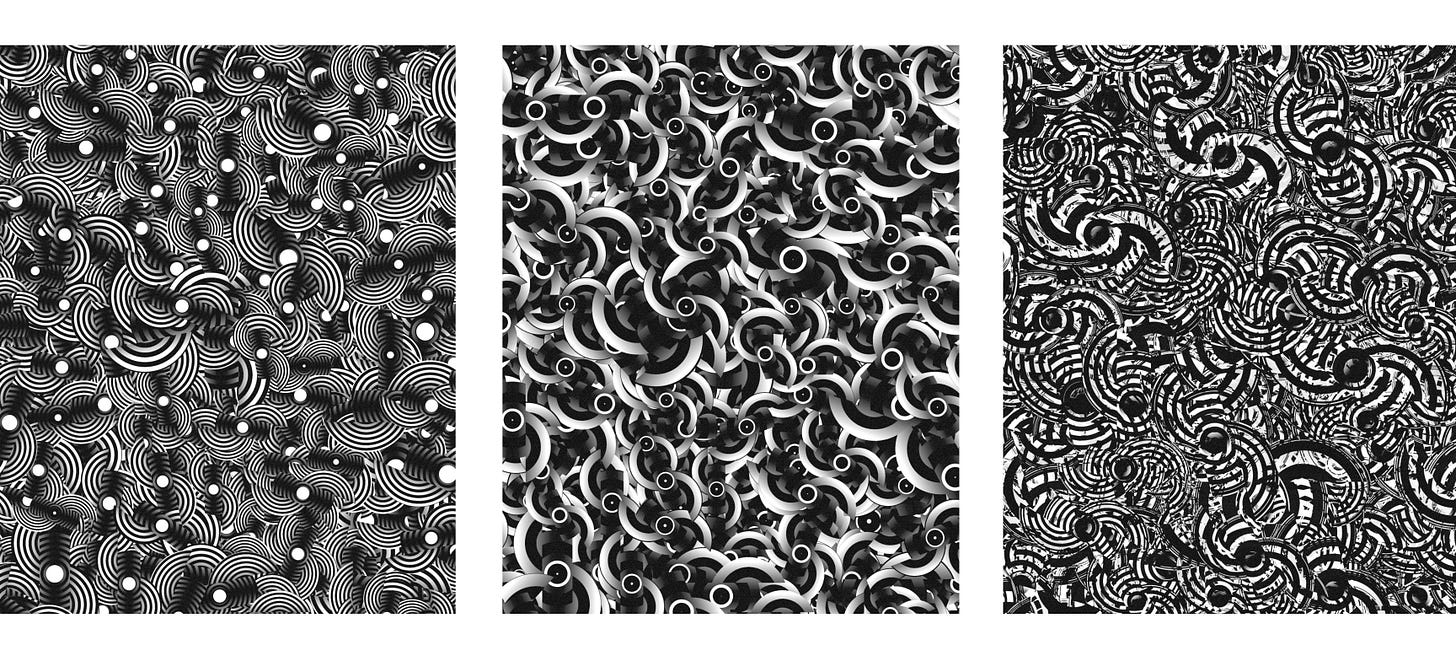Juan Pedro Vallejo gives us an introduction to Pure visibility and Neocinetic art
Light. Movement. Instability. #purevisibility #neocinetic #art
Once upon a time in September of 2021, I was scrolling Twitter, when I had to completely stop and admire a tweet from fellow collector and friend, Antonio Marinara (@Toni_Marinara), “Resident Wise Guy”. He had just successfully acquired #001 from the VISIBILITY ACCUMULATION collection, by Argentinian artist Juan Pedro Vallejo (@juanpvallejo). This collection was entirely created in his Fragma app, which we will discuss more about later. Another phenomenal series of generative works is the FAKE SPECTRUM series where Juan looks to generate colors that do not exist in the image. Mind-blowing to say the least.
Juan is such an exceptional artist and I’ve been following him and his work ever since.
When did you discover yourself as an artist?
If I think about my history, I think there was a time when I was 10 years old that my dad taught me Adobe Flash on Sundays. We spent the morning listening to Pink Floyd and cheering things up… I think that was decisive, on an unconscious level. Years later he taught me very basic programming things that he had forgotten. And then I started programming. In my adolescence I was interested in music, I studied piano for several years as well as cinema at university. Today I consider myself a plastic/visual artist. It can be said that most of my life I was interested in art. I really don't know why.
What got you into NFTs?
It was definitely Dmitri's “Ringers”… I followed his work on instagram long before the NFT days. We even exchanged messages on several occasions, something that I find fascinating, that predisposition that artists sometimes have to be open to talking to people from all over the world. When I saw “Ringers” and discovered Art Blocks I immediately knew I wanted to be there. What they are doing is really amazing and historic. Then I saw several collections that fascinated me, such as “Apparitions” by Aaron Penne, “Trossets” by Anna Carreras, “Loom” by Anna Lucia. I spent the last 6 months putting together my project (slow work I think) and in the meantime I published some works on Foundation, which allowed me to earn some money to pay off debts. It was really great to meet so many people who value your work, until that moment I didn't know what it felt like.
You use the terms “Pure Visibility” and “Neo Cinetic” to refer to your art. Can you explain what these terms mean in general (for those who don’t know) and what they mean to you in relation to your art?
Pure visibility are two words that I put together to express a departure from the idea that a meaning has to prevail in art. It is a counter response to explanation, be it academic or critical of any kind. What matters is what is visible. The work is what is there, in front of your eyes. It is closely related to the field of art that I am interested in participating in, which is kinetic art.
The kinetics sought to generate visual situations where the experience is more important than the interpretation, moving away from the meanings and downplaying the figure of the author in the generation of the work. That connects it with generative art, where the artist programs and generates certain rules, as if they were a field of possibilities, a playground, a space of possible relationships... This frames the works within an aesthetic category that I like a lot, which is the "open work".
Neokineticism is a concept coined by an Argentine author, Elena Oliveras, to designate a contemporary continuity with the kinetic production of the previous century. For me, it's about bringing those two fields together; the field of kinetic art and the field of generative art.
The first collection I ever saw of yours was VISIBILITY ACCUMULATION on Foundation. The description is “Multiple energies looking for their place in pictoric space.” Can you explain this piece and its associating collection in further detail? What does it mean to you?
Visibility accumulation was a collection that I was making at the time I was making the INTERFERENCES collection (coming soon). As the description says, it was about ordering the elements in the shot a little, playing with the compositions and looking for dynamism and movement. This collection has a limit of 10 pieces, of which only 6 have been minted so far.
Like INTERFERENCE PARANOIA, if someone is interested in one of them, I send them a folder with possible outputs so that the interested party can choose. This mechanism is good because it puts you in direct contact with collectors, who are usually interesting people and genuinely interested in your work (at least mine). The last mint was chosen by a person who wanted to scam me, which was very funny and sad, but quickly the NFT community helped me unmask the scammer.
Light. Movement. Instability. What do these words mean to you?
When I was a film student, I used to watch a lot of movies. I was fascinated by directors like Antonioni, who have a geometric way of composing his frames. Little by little I developed a completely plastic/visual way of analyzing films. I forgot about the story and the plot, and only saw directions, vectors, forces moving from one side of the screen to another and interacting with each other. I realized how complex it is to make an image work, and yet it seems to be something that comes to us very instinctively.
Light is the starting point for everything visible, and it is also a theme in some of my video works. I think about the origin of light. Where does it come from? It fascinates me not being able to fully understand what happens in outer space, what happens where there is absolute darkness... is there memory?
Movement, on the other hand, I think is what makes us human, gives us the possibility of transformation. I think it was Kandinsky who said that a line was a point moving in the plane. I believe that movement is a very complex subject in the art world, and that it also connects my cinematographic training with my tendencies towards kinetic art, a field in which movement and instability is one of its greatest problems.
Which collection of yours is most important to you and why?
I think the most important collection is going to be INTERFERENCES, my first long collection. (Not yet published at the time of this interview) I like where I started from and where I am going. It was a long process, in which I was discovering the work as I was doing it. It left me with a very deep investigation on color that will accompany me in future works. I like that this work can dialogue with artists I admire, in one way or another, taking their research and taking it further, or participating within the same symbolic field. Also, the INTERFERENCE(T) shape is probably the most iconic and “original” thing I've done so far and I'm totally excited to release this project in the near future.
What is the Fragma app? Why did you invent it?
Fragma is an application that I have been making for a few years to compose images in real time. It's basically an interface with parameters that I can adjust to produce different types of images, although it was originally intended for animation and live performance. I used it a lot during my time at university. All my work at the university was done with Fragma. I was even able to travel to Portugal for an art and technology residency to perfect it in 2018.
Since I don't consider myself a regular programmer, the intention was to create a modular workstation that would allow me to add parts as needed. That is, instead of having a thousand different sketches, gather them all in one place. Fragma comes from Fragment, and it refers to just that. Today I no longer deny having to program so much, although it is not an activity that I particularly enjoy either. I do not find the code itself an interesting place, for me it is an extremely powerful and contemporary tool and that is why I use it. I always think how vast Bach's work would be if programming had existed.
I’m curious, do you have any rituals to get you inspired or listen to any specific music when creating?
I've been listening to Radiohead's Jonny Greenwood solo albums lately. He has movie soundtracks that are truly extraordinary. I don't really have any ritual. What I do is see a lot of art, every day. All the time I am looking for artists and discovering new things. It is something that I take with responsibility, after all, it would be absurd not to take advantage of the opportunity to access the information we have today. I like to think what I see, make connections... I think it helps to develop an analytical capacity and that later has an impact on production. productions of all kinds. Right click and save.
Can you explain the concept behind your FAKE SPECTRUM series?
The FAKE SPECTRUM series are 3 simple exercises where I sought to generate colors that do not exist in the image. It is a continuation or a study of the work of the kinetic artist Carlos Cruz Diez. It's fantastic how perception works, that with just 3 colors you can generate a full range of intermediate values that exist in the eye and not in the image. Cruz Diez worked on this throughout his life.
However, I believe that the IRRADIATION series is a continuation and a contribution. Because in these works, instead of using solid colors, like Cruz Diez, I use gradients, and the possibility of generating new movement effects is multiplied. They are works that, furthermore, can only exist thanks to the digital, since painting so many gradients with that level of precision would be impossible.
The black and white monochrome pieces from your Interference Paranoia collections are absolutely beautiful - That whole collection is stellar. How did this output come about?
INTERFERENCE PARANOIA arose from a nightmare. I dreamed that I was in the house where I lived when I was a child and the form appeared to me in the garden and advanced towards me, wanting to enter the house. Many times I dream of art but rarely can I remember it. But in this case it was a simple matter, the series is basically about multiplying the shape in the plane and playing with the overlaps, something that the boy of my dream would probably do. PARANOIA, like VISIBILITY ACCUMULATION… they were series that appeared while I was working on INTERFERENCES, so they were a counterpoint, I appreciate them a lot.
Are you interested in learning/experimenting with new art forms and styles?
I could say no, because what really interests me now is to delve into the searches that I have been opening recently. But it would be absurd to anticipate, since I always try to be open to new media. I am interested in investigating the physical world, I have some works planned for the next time: sculptures and silk screens. I am also interested in being able to participate in exhibitions, since I have rarely done so in my life. Although I have always been an artist, the truth is that I have been in contact with collectors and galleries for a very short time… I really enjoy the state of the art world today, of course crossed by NFTs. Seeing that Art Blocks was at the Venice Biennale is really encouraging and motivating, to give an example. Programming my own smart contracts is probably the next step.
What are you looking forward to most about the future?
As I was saying, participate in more exhibitions, make murals, take my work to other places. Also, build my own studio where I can produce, with printers and any tools that I may need.
Have you ever considered collaborating with other artists in the NFT or non-NFT space?
Yes absolutely. I would very much like to do a collaboration with another Argentine artist named Mariano Ramis, owner of a particular and captivating style. He works with moving images in a very experimental way, I don't know what his process is (I think it's a hybrid between analog and digital) but he obtains truly fascinating results. He worked with Juana Molina, as well as posting some really amazing NFTs.
Is there anything you hope to accomplish by the end of the year?
I would like to be able to produce an edition of physical objects and publish them as NTFs. Find ways for them to interact. Continue investigating the possibilities of all these wonderful new technologies that permeate our contemporaneity. Make exhibitions and continue meeting artists and collectors that inspire me to continue creating
It’s always a pleasure when we get to chat together. Thank you again - we’re all looking forward to the release of INTERFERENCES (coming soon) and everything else you plan on releasing in the future!












Great read! “INTERFERENCE PARANOIA” might be my fave.